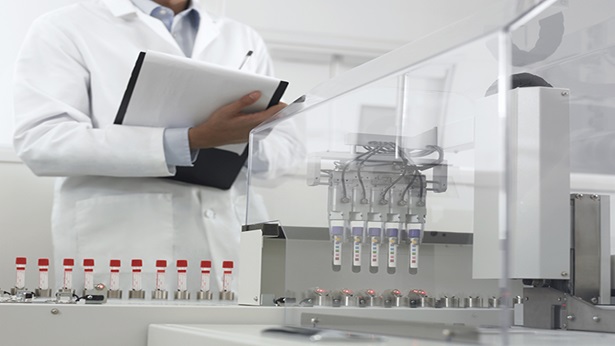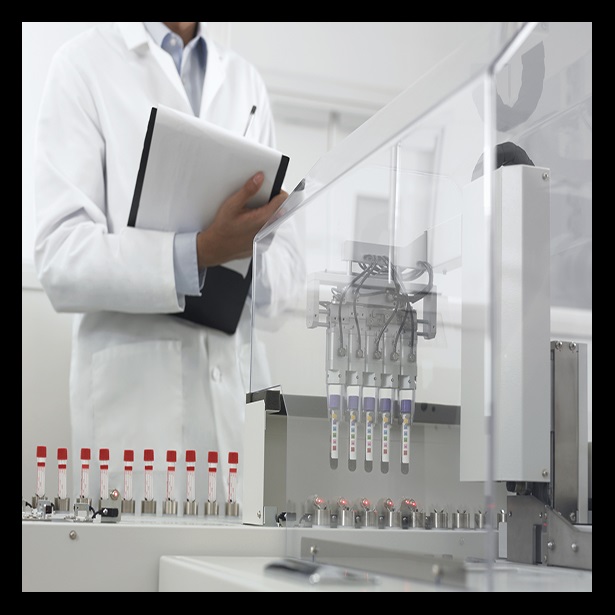‘Gram-Negative Bacteria Pose a Significant Scientific Challenge’
National Institute of Allergy and Infectious Diseases director discusses efforts to defeat dangerous superbugs

The National Institute of Allergy and Infectious Diseases (NIAID), part of the National Institutes of Health, conducts and supports biomedical research to address antimicrobial resistance, a global public health threat of increasing concern. Dr. Anthony Fauci has served as director of NIAID since 1984, advising five presidents on many domestic and global health issues.
In the fight against what are commonly known as superbugs, the institute engages in basic, translational and clinical research aimed at finding innovative solutions to better diagnose, treat, and prevent antimicrobial-resistant infections. To tackle these complex issues, NIAID collaborates with other federal agencies, academic institutions, private companies, nonprofits, and health care providers through various partnerships, including the Antibacterial Resistance Leadership Group (ARLG) and the Transatlantic Task Force on Antimicrobial Resistance (TATFAR).
Fauci answered questions from Pew about the threat of antimicrobial resistance (AMR) and the work being done by the NIAID on this front.
Q. Recent analyses by the World Health Organization and Pew found there are only 12 antibiotics currently in development globally that have the potential to treat critical threat pathogens. Why aren’t there more antibiotics in development to treat the most dangerous superbugs? What do you see as the most difficult challenges to new antibiotic discovery?
A. We face several hurdles in developing novel antibiotics to treat resistant infections. Gram-negative bacteria, such as Escherichia coli and Pseudomonas aeruginosa, pose a significant scientific challenge because their unique cell wall features make it difficult for antibiotics to work effectively. In addition, we have virtually exhausted traditional drug discovery resources, such as chemical libraries and finding bacteria- and fungi-derived antibiotics in the environment that can be grown easily in the laboratory. However, investigators are developing tools to identify sources of naturally-occurring antibiotics. For example, a new technology called iChip can screen previously unculturable organisms in soil.
Certain characteristics of the antibiotic market, such as short treatment duration, generally low prices and restricted access to consumers, disincentivize pharmaceutical companies from making investments in creating new drugs. In this regard, a public-private collaboration called the Combating Antibiotic Resistant Bacteria Biopharmaceutical Accelerator (CARB-X), and policy initiatives, such as the “Generating Antibiotic Incentives Now” law enacted in 2012, encourage development of new antibiotics. Furthermore, even when a novel antibiotic is identified, it can be difficult to enroll participants in clinical trials because of the sporadic incidence of infections and the likelihood that hospitalized patients already will have taken antibiotics.
Q. You have the vantage point of overseeing many high-priority areas. Are there any lessons that can be learned from research breakthroughs in other areas (i.e., HIV/AIDS) that could apply to AMR?
A. In the 1980s, a person with advanced HIV/AIDS could expect to live only a few months after diagnosis, whereas today, a 20-year-old who is newly diagnosed and treated immediately with combinations of effective antiretroviral drugs can expect to live a nearly normal lifespan. The HIV/AIDS experience teaches us that an accelerated, multidisciplinary research effort can yield enormous biomedical advances. However, such achievements require sustained funding, transparency, infrastructure development, and global collaboration among researchers, industry, nonprofits, clinical trial participants, and health care professionals.
Q. What is the role of vaccines, immunotherapies and other types of “nontraditional” products in combating antibiotic-resistant infections?
A. NIAID supports multiple approaches to antimicrobial resistance research beyond traditional drug discovery and development. For example, scientists are exploring ways to harness the immune system to prevent infections. These strategies include developing and testing vaccines for health care-associated infections that could be administered to targeted at-risk populations. Preventing bacterial infections in the first place is the best way to avoid problems of antibiotic resistance.
Monoclonal antibodies also are being evaluated as preventative therapy and for use in combination with antibiotics in severely ill patients. Other promising approaches involve manipulating microbial communities—the diverse bacteria, fungi, and viruses that inhabit the human body—to treat infection. These include using fecal microbiota transplants to treat Clostridium difficile as well as creating “live biotherapeutics” to restore normal gut function.
Viruses that infect bacteria, called bacteriophages, also are being studied because of their ability to kill drug-resistant bacteria with high specificity, thereby preserving the microbiota by avoiding the broader antibacterial effects of many antibiotics. Finally, rather than killing bacteria, some scientists are researching how to target various virulence factors, or the factors that make bacteria dangerous to us.
In addition to researching “nontraditional” products, NIAID aims to improve diagnostic testing to ensure that patients receive the correct antibiotics. Current inappropriate use of broad-spectrum antibiotics applies selective pressure to bacteria and encourages the emergence of antimicrobial resistance. NIAID and the [Department of Health and Human Services] Office of the Assistant Secretary for Preparedness and Response (ASPR) support the Antimicrobial Resistance Diagnostic Challenge to foster innovative approaches to diagnostic tests that rapidly—within hours, rather than days—identify and characterize antibiotic-resistant bacteria and/or distinguish between viral and bacterial infections.
Q. Congress recently increased funding for biomedical research at NIH, including for research related to antibiotic resistance. How does this factor in to NIAID decisions on what kind of antibiotic-resistance research to fund? Can you tell us a little bit about what NIAID is funding in the area of antibiotic resistance now?
Q. NIAID funds antibiotic-resistance research in multiple ways. First, consistent with NIH processes, NIAID funds highly meritorious basic and translational biomedical research grants, which undergo two levels of peer review. The first level of review is carried out by a scientific review group (SRG) composed primarily of non-federal scientists who have expertise in relevant scientific disciplines and current research areas. The second is performed by NIAID’s advisory council.
Councils are composed of both scientific and public representatives chosen for their expertise, interest, or activity in matters related to health and disease. Only applications that are recommended for approval by both the SRG and the advisory council may be recommended for funding. Final funding decisions are made by the relevant institute or center directors.
In addition, NIAID identifies significant research gaps and issues funding opportunity announcements to stimulate additional investigation in these areas. For example, in fiscal year 2016, NIAID awarded approximately $5 million to 24 research projects seeking to develop nontraditional therapeutics for bacterial infections. These include bacteriophage-related projects, such as engineering phages to provide broad-spectrum coverage across several different multidrug-resistant pathogens. In fiscal year 2018, NIAID funded four projects supporting the development of novel predictive assays, models, and research tools to facilitate therapeutic discovery for select gram-negative bacteria, including Carbapenem-Resistant Enterobacteriaceae (CRE), multidrug-resistant Aceinetobacter and/or multidrug-resistant Pseudomonas aeruginosa.
NIAID also provides data and materials to researchers to enable progression of candidate vaccines, diagnostics, and therapeutics through the product development pathway. For example, NIAID provided preclinical services and sponsored a Phase 1 clinical trial of intravenous fosfomycin, a broad-spectrum antibiotic effective against many multidrug-resistant isolates (e.g., MRSA, CRE, colistin-resistant bacteria). NIAID has also provided preclinical services and technical support to awardees of the CARB-X program, which supports the discovery and early development of antibacterial products.
In addition, NIAID provides support for clinical trials of new drugs, vaccines, and treatment regimens to help mitigate the effects of resistance. For example, the ARLG has initiated over 35 clinical studies and trials, including clinical testing of new drugs to treat multidrug-resistant Gram-negative bacteria, evaluating diagnostic devices in clinical settings, evaluating the effectiveness of new antibacterial stewardship programs, and optimizing treatment regimens to reduce the emergence of resistance.
Q. NIAID’s recent funding opportunities for research into antibiotic-resistant bacteria have focused on milestone-driven projects and encouraged applications from multidisciplinary teams. Why are those aspects important?
A. These funding opportunities center on translational research and/or product development. Identifying milestones for such research projects maintains a focus on discovery and development of tangible candidates (e.g., drugs and vaccines) that meet necessary performance criteria and facilitate decision-making at each stage of product development. Multidisciplinary teams bring varied expertise to projects to better anticipate and address challenges inherent to product development, such as industrial and regulatory issues. This approach facilitates efficient use of time and resources to generate effective medical countermeasures suitable for further development.
Q. One of the key priorities identified by scientists at last year’s Pew-NIAID workshop on Gram-negative bacteria was the need for a platform that enables the research community to better access, share, and use existing and prospective antibiotic discovery information. Why is improved information sharing so important to finding new types of antibiotics?
A. Scientists across the globe are actively researching various approaches to tackle antimicrobial resistance. However, valuable insights and opportunities can be overlooked if the resulting data are published and dispersed across various journals and data repositories or remain unpublished, limiting access for use and re-use by the scientific community. Rather than operating in silos, specialized information-sharing platforms allow sharing and access to data in one environment so that we can see the “big picture” and consider new scientific questions. This type of data repository has been used in cancer research through the NCI Genomic Data Commons, which allows sharing and access to cancer genomic studies.
Q. When you look at the antibiotic discovery and development space, what keeps you up at night? And what gives you hope? Moving forward, what does NIAID plan to do to continue fighting the threat of antibiotic resistance?
A. Antimicrobial resistance is one of the most concerning public health threats that we face. Multiple factors have combined to create a global crisis requiring a multifaceted solution that includes development of new antibiotics. Many novel approaches to combating antimicrobial resistance are in the early stages of development. However, I am encouraged by the progress made thus far, and NIAID remains committed to the comprehensive strategies and goals laid out by various national and international groups tackling antimicrobial resistance. Importantly, as we work toward developing novel biomedical countermeasures, we also must take immediate steps to mitigate the effects of resistant bacteria through effective prevention, antimicrobial stewardship programs, and surveillance.













